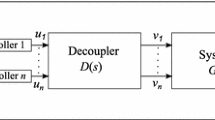Abstract
In this paper, a basic dynamic model of the supply chain system is constructed in which the oscillation problems caused by the time delay in remanufacturing, ordering, the disturbance of the system parameters are considered along with the customers’ demand estimation. Time delay in production systems affects the efficiency of supply chain and lead to the bullwhip effect. This paper proposes a new method according to the model structure for controlling the bullwhip effect based on state dependent Riccati equation (ESDRE) and designing suboptimal sliding manifolds for a nonlinear supply chain in the presence of input and state delays. A switching control scheme is obtained based on the designed suboptimal sliding manifold. It is proved that this control scheme can guarantee that the nonlinear supply chain system is asymptotically stable and understand soft switching among subsystems of the nonlinear supply chain to mitigate fluctuations in the system variables. The efficiency of suboptimal sliding manifold method was examined by comparing LQR method in the presence of various time delays. Also, simulation investigation in real supply chain proved this efficiency.

















Similar content being viewed by others
References
Asif FM, Bianchi C, Rashid A, Niclescu CM (2012) Performance analysis of the closed - loop supply chain. J Remanufacturing 2(1):1–21
Aslani S, Khaloozadeh H, Soltanian F (2019) Nonlinear modelling and performance analysis of a closed-loop supply chain in the presence of stochastic noise. Math Comput Model Dyn Syst 25(5):499–521
Aslani S, Khaloozadeh H, Soltanian F (2021) Regulating bullwhip effect in supply chain with hybride recycling channels using inear quadraticguassian controller. Int J Ind Eng Prod Res 32(1):13–27
Aslani S, Skandari S (2021) The design of inverse network DEA model for measuring the bullwhip effect in supply chains with uncertain demands. J Optim Ind Eng 14(2):203–214
Agaran, B., Walter, W., Buchanan, M, K. and Yurtseven. (2007) Regulating bullwhip effect in supply chain through modern control theory. IEEE Conference USA.
Batmani Y, Khaloozadeh H (2015) On the design of suboptimal sliding manifold for a class of nonlinear uncertain time-delay systems. Int J Syst Sci 47(11):2543–2552
Batmani Y, Khaloozadeh H (2014) On the design of observe for nonlinear time-delay systems. Asian J Control 16(5):1–11
Beamon F, Benita M (1998) Supply chain design and analysis: models and method. Int J Prod Econ 55:281–294
Chen F, Drezner Z, Ryan J, Simchi-levi D (2000) Quantifying the bullwhip effect in a simple supply chain: the impact of forecasting, lead time, and information. Manage Sci 46:436–443
Dejonckheere J, Disney SM, Lambrecht MR, Towill DR (2003) Measuring and avoiding the bullwhip effect. Eur J Oper Res 147:567–590
Forrester JW (1958) Industrial Dynamics, A major breakthrough for decision makers. Harv Bus Rev 34:67–96
Gao N, Ryan SM (2014) Robust design of a closed loop supply chain network for uncertain carbon regulations and random product flow. Euro J Transport Logist 3(1):5–34
Geunes J, Romeijin HE, Taaffe K (2002) Model for integrated production planning and order selection. Industrial Engineering Research, Orlando
Glock CH (2012) Lead time reduction strategies in a single vendor single- buyer integrated inventory model with lot size dependent lead times and stochastic demand. Int J Prod Econ 136(1):37–44
Heydari J (2014) Lead time variation control using reliable shipment equipment: an incentive scheme for supply chain coordination. Transp Res Part E Logist Transp Rev 63:44–58
Jun P, Panos M, Pardalos X, Liu W, Fan S, Yang. (2015) Serial batching scheduling of deteriorating jobs in a two-stage supply chain to minimize the makespan. Eur J Oper Res 244:13–25
Jun P, Xinbao L, Wenjuan F, Panos M, Pardalos S, Lu. (2019) A hybrid BA-VNS algorithm for coordinated serial-batching scheduling with deteriorating jobs, financial budget, and resource constraint in multiple manufacturers. Omega 82:55–69
Jha JK, Shanker K (2014) An integrated inventory problem with transportation in a divergent supply chain under service level constraint. J Manufacturing Syst 33(4):462–475
Leng M, Parlar M (2009) Lead-time reduction in a two-level supply chain: non-cooperative equilibria versus coordination with a profit-sharing contract. Int J Prod Econ 118(2):521–544
Li Ch, Liu S (2013) A robust optimization approach to reduce the bullwhip effect of supply chains with vendor order placement lead time delays in an uncertain environment. Appl Math Model 37:707–718
Li T, Ma J (2014) Complexity analysis of the dual-channel supply chain model with delay decision. Nonlinear Dyn 78:2617–2626
Li Y, Xuejun J, Ye F (2011) Supply chain coordination model with controllable lead time and service level constraint. Computers and Industrial Engineering 61(3):858–864
Mahajan S, Venugopal V (2011) Value of information sharing and lead time reduction in a supply chain with auto correlated demand. Technol Oper Manag 2(1):39–49
Michna Z, Nielsen P, Nielsen L (2018) The impact of stochastic lead times on the bullwhip effect – a theoretical insight. Prod Manuf Res 6(1):190–200
Park S, Lee T, Sung CS (2010) A three-level supply chain network design model with risk-pooling and lead times. Transp Res Part E Logist Transp Rev 46(5):563–581
Pin-Ho L, Shan-Hill D, Shi Shang J (2004) Controller design and reduction of bullwhip for a model supply chain system using z-transform analysis. J Process Control 14:487–499
Tersine RG, Hummingbird EA (1995) Lead-time reduction: the search for competitive advantage. Int J Oper Prod Manag 15(2):8–18
Wandong Lou, Junhai M, Xueli Zh (2017) Bullwhip Entropy Analysis and Chaos Control in the Supply Chain with Sales Game and Consumer Returns. Entropy. https://doi.org/10.3390/e19020064
Zimmer K (2002) Supply chain coordination with uncertain just-in time delivery. Int J Prod Econ 77(1):1–15
Zhang G, Shang J, Li W (2011) Collaborative production planning of supply chain under price and demand uncertainty. Eur J Oper Res 215(3):590–603
Author information
Authors and Affiliations
Corresponding author
Additional information
Publisher's Note
Springer Nature remains neutral with regard to jurisdictional claims in published maps and institutional affiliations.
Rights and permissions
About this article
Cite this article
Khiavi, S.A., Khaloozadeh, H. & Soltanian, F. Suboptimal sliding manifold For nonlinear supply chain with time delay. J Comb Optim 42, 151–173 (2021). https://doi.org/10.1007/s10878-021-00733-1
Accepted:
Published:
Issue Date:
DOI: https://doi.org/10.1007/s10878-021-00733-1




